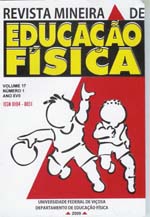ANALYSIS OF KNEE JOINT ANGLES IN START IN RELATION TO THE FINAL TIME IN BMX CYCLING
Keywords:
angle joint, cycling, BMXAbstract
This study aimed to analyze the knee joint angles during the starting and the possible correlations with the final time of BMX cycling race in an official competition of the sport. Twenty (20) male athletes participated of this study, of “Elite” and “Junior Men” categories with a mean age of 20.3 ± 3.0 years old, which regularly participate of state, national and international competitions, all having more than five years of experience in BMX cycling competitive practice. The knee joint angle was measured three times during the beginning: in the static position, in the first noticeable movement and at the start time, in other words, to overcome the starting gate. Moreover, the correlation between the start angle and the total time of the Time Trial was made. It was found a significant difference between the angle of the first movement with respect to the angles of the static position and the start angle. There was no significant correlation between the start angle and the total time of the Time Trial. The study concludes that the total race time has no correlation with the athletes’ start angle, perhaps because, even as a short-term effort, on average 35 seconds, the curves and obstacles in the path are situations that make a difference for the best athletes in obtaining the best results.
Downloads
References
BREED, R.V.P.; YOUNG, W.B. The effect of a resistance training programme on the grab, track and swing starts in swimming. J. Sports Sci., v. 21, n. 3, p. 213-220, 2003.
CHELLY, M.S.; FATHLOUN, M.; CHERIF, N.; BEN AMAR, M.; TABKA, Z.; VAN PRAAGH, E. Effects of a back squat training program on leg power, jump, and sprint performances in junior soccer players. J. Strength Cond. Res., v. 23, n. 8, p. 2241-2249, 2009.
CORREA, C.S.; SILVA, B.G.C.; ALBERTON, C.L.; WILHELM, E.N.; MORAES, A.C.; LIMA, C.S; PINTO, R.S. Análise da força isométrica máxima e do sinal de EMG em exercícios para os membros inferiores. Rev. Bras. Cineantropom. Desempenho Hum. (Online), v. 13, n. 6, p. 429-435, 2011.
COWELL, J.F.; MCGUIGAN, M.R.; CRONIN, J.B. Movement and skill analysis of supercross bicycle motocross. J. Strength Cond. Res., v. 26, n. 6, p. 1688-1694, 2012.
DE JESUS, K.; DE JESUS, K.; FIGUEIREDO, P.; GONÇALVES, P.; PEREIRA, S.; VILAS-BOAS, J.P.; FERNANDES, R.J. Biomechanical analysis of backstroke swimming starts. Int. J. Sports Med., v. 32, n. 7, p. 546-551, 2011.
GIANIKELLIS K.; BOTE A.; PANTRIGO J.J.; TENA J.A. (2004) Análisis biomecánico de la salida en la carrera de BMX. In: CONGRESS OF THE SPANISH ASSOCIATION OF SPORTS SCIENCES, 3. University of Valencia (Spain). Disponível em: <http://www.eweb.unex.es/eweb/cienciadeporte/congreso/04%20val/pdf/c184.pdf>. Acesso em: 09 set. 2014.
GILBERT, P.; MCEWAN, K.; BELLEW, R.; MILLS, A.; GALE C. The dark side of competition: how competitive behaviour and striving to avoid inferiority are linked to depression, anxiety, stress and self-harm. Psychol Psychother., v. 82, n. 2, p. 123-136, 2009.
JOB, C. BMX. 2. ed. Minneapolis: Lerner Sports, 2004.
MATEO-MARCH, M.; FERNÁNDEZ-PEÑA, E.; BLASCO-LAFARGA, C.; MORENTE-SÁNCHEZ, J.; ZABALA, M. Does non-circular chainring improve performance in the Bicycle Motocross Cycling start sprint? J. Sports Sci. Med., v. 13, n. 1, p. 97-104, 2014.
MERO, A.; KUITUNEN, S.; HARLAND, M.; KYRÖLÄINEN, H.; KOMI, P.V. Effects of muscle-tendon length on joint moment and power during sprint starts. J. Sports Sci., v. 24, n. 2, p.165-173, 2006.
ZABALA, M.; SÁNCHEZ-MUÑOZ, C.; MATEO, M. Effects of the administration of feedback on performance of the BMX cycling gate start. J. Sports Sci. Med., v. 8, n. 3, p. 393-400, 2009.
Downloads
Published
How to Cite
Issue
Section
License
Os artigos submetidos e publicados são de inteira responsabilidade de seus autores, não refletindo necessariamente a opinião do Comitê Editorial. A revista se reserva o direito de efetuar, nos originais, alterações de ordem normativa, ortográfica e gramatical, com vistas a manter o padrão culto da língua, respeitando, porém, o estilo dos autores. O manuscrito submetido deve ser original, não podendo ter sido publicado em qualquer outro veículo de informação científica, e nem submetido para publicação em outra revista científica. Os trabalhos publicados passam a ser propriedade da revista Mineira de Educação Física, ficando sua reimpressão total ou parcial de acordo com a licença Creative Commons Attibution 4.0. Deve ser consignada a fonte de publicação original. Os originais não serão devolvidos aos autores. As opiniões emitidas pelos autores dos artigos são de sua exclusiva responsabilidade.





 Esta obra está licenciada com uma Licença
Esta obra está licenciada com uma Licença 